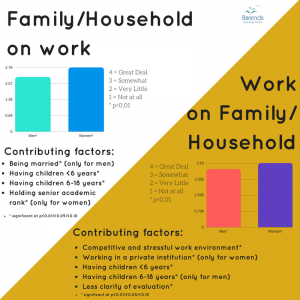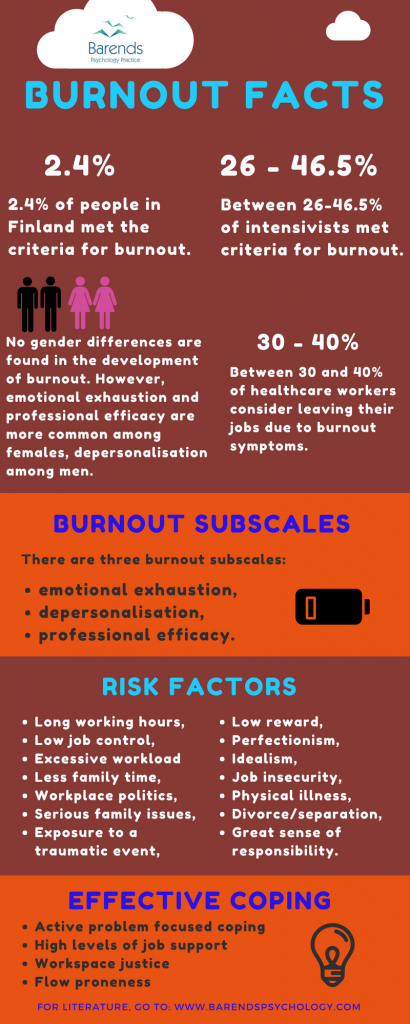Partner with burnout: What can you do to help?
Being in a relationship with someone who has a burnout is challenging for both partners individually and for the relationship itself. Often, the balance in the relationship shifts in such a way that the partner of the person with burnout (from now on we refer to this person as just ‘partner’) needs to take care of (more) home chores, bills, and children/pets. The partner with burnout just does not have the energy to do the simplest of tasks. This imbalance may hold for a while, but starts taking its toll on the partner eventually. The partner may grow resentful or angry towards the partner with burnout, may feel like a secretary or servant, and may start doubting their relationship altogether.
This page discusses strategies to reduce the impact burnout has on a relationship, gives advice on how to support your partner with burnout, and focuses on tips to reduce the suffering of the partner.
At Barends Psychology Practice, we offer treatment for burnout. Go to contact us to schedule a first, free of charge, session. (Depending on your health insurance, treatment may be reimbursed).
Go to:
Partner with burnout – effects of family life on burnout
 Both stress at home and at work can contribute to the development of burnout [6],[7]. Having children, doing more home chores, having an emotionally unavailable partner, being married (for men), and holding a senior rank (in women) increases burnout rates among working parents. Having an emotionally available partner, doing less home chores or doing more activities with children (compared to home chores), however, decreases burnout rates among working parents [3],[6],[7].
Both stress at home and at work can contribute to the development of burnout [6],[7]. Having children, doing more home chores, having an emotionally unavailable partner, being married (for men), and holding a senior rank (in women) increases burnout rates among working parents. Having an emotionally available partner, doing less home chores or doing more activities with children (compared to home chores), however, decreases burnout rates among working parents [3],[6],[7].
At the same time, family conflicts are more common when a job is emotionally demanding. Negative emotional arousal at work predicts angrier marital behaviour for women, and more withdrawn behaviour for men [1],[2]. A possible reason for this could be that showing negative emotions at work is not accepted, and thus taken home. At home, it is easier and more accepted to show negative emotions, which leads to more family conflicts [1],[2].
In other words, having a partner with burnout has a negative effect on family life.
Fortunately, there are a few things the partner can do to help reduce burnout symptoms.
Partner with burnout – helping your partner reducing their burnout symptoms
Family support is effective in reducing burnout symptoms [5]. Family support basically means any type of support a partner can offer to help reducing burnout symptoms. Here is an overview:
Home chores:
Taking over home chores, as a partner, reduces burnout more in women, compared to men [4], because on average, women still do more home chores. Of course, in households where men do the majority of the home chores, their burnout symptoms reduce more if their partner takes over some home chores. Home chores may seem small and not very time consuming, but the emotional effect they have on someone can be significant, especially for someone who is burned out. Also, the type of home chores play a role in the reduction of burnout; doing activities with children reduces burnout more than cleaning does [6]. How can you help? Ask your partner with burnout what they can do (and like to do) on a daily or weekly basis and try to take over the rest of the activities. For those who are not familiar with a routine, please consider introducing one. A routine reduces burnout, procrastination, miscommunication, and frustration, because one does the same task on a daily or weekly basis.
(Advertisement. For more burnout treatment information, continue reading).
Clear communication:
Clear communication is extremely important in a relationship, because it takes away uncertainty, reduces frustration and can prevent arguments [8]. Communication can be very challenging for someone with burnout, because of their emotional exhaustion and extreme fatigue. For someone with burnout it can be extremely tiring to have to listen to someone complaining, to have to repeat themselves, to fight over small disagreements, to have long discussions, and to have to explain themselves a lot. A natural response is to withdraw socially and to stop communicating. For the partner it is important to keep conversations to the point, to use post-its to remember something or to remind the other, to give your partner enough space, and to put your own needs and demands second.
Here is a list of common problems regarding communication:
We are interested in your experience regarding communication. Please select the options that apply for you(r partner with burnout) as well:
For a detailed article on communication in relationships, please click here. This page discusses preventing many of the above mentioned common communication problems.
Practicing work-related conversations:
Practicing difficult work-related conversations at home helps reducing stress, emotional exhaustion and burnout in general in your partner with burnout [3], because he or she can prepare well, apply the given feedback, rephrase sentences, adjust composure, and practice with difficult answers and different attitudes. A good preparation lowers anxiety levels, boosts confidence levels, and reduces stress levels.
Being available and pro-active:
Being available might be one of the more difficult things to change. Having a full time job, hobbies, and other obligations can be quite demanding. The extensive usage of tablets, laptops, and smartphones nowadays does not add to our availability either. However, being available and pro-active takes away a lot of irritation, miscommunication, and other tiring aspects in a relationship. Putting the phone, tablet or laptop away when your partner is around is a good start. Keeping track of all the things that need to be done and doing them in time, gives your partner just that little bit of extra rest.
Literature
- [1] Schulz, M. S., Cowan, P. A., Pape Cowan, C., & Brennan, R. T. (2004). Coming home upset: Gender, marital satisfaction, and the daily spillover of workday experience into couple interactions. Journal of Family Psychology, 18, 250.
- [2] Carlson, D., Ferguson, M., Hunter, E., & Whitten, D. (2012). Abusive supervision and work–family conflict: The path through emotional labor and burnout. The Leadership Quarterly, 23, 849-859.
- [3] Noor, N. M., & Zainuddin, M. (2011). Emotional labor and burnout among female teachers: Work–family conflict as mediator. Asian Journal of Social Psychology, 14, 283-293.
- [4] Blanch, A., & Aluja, A. (2012). Social support (family and supervisor), work–family conflict, and burnout: Sex differences. Human Relations, 65, 811-833.
- [5] Bratis, D., Tselebis, A., Sikaras, C., Moulou, A., Giotakis, K., Zoumakis, E., & Ilias, I. (2009). Alexithymia and its association with burnout, depression and family support among Greek nursing staff. Human Resources for Health, 7, 72.
- [6] Lieke, L., van der Lippe, T., Kluwer, E. S., & Flap, H. (2008). Positive and negative effects of family involvement on work-related burnout. Journal of Vocational Behavior, 73, 387-396.
- [7] Fox, M. F., Fonseca, C., & Bao, J. (2011). Work and family conflict in academic science: Patterns and predictors among women and men in research universities. Social Studies of Science, 41, 715-735
- [8] Michie, S., & Williams, S. (2003). Reducing work related psychological ill health and sickness absence: a systematic literature review. Occupational and environmental medicine, 60, 3-9.

